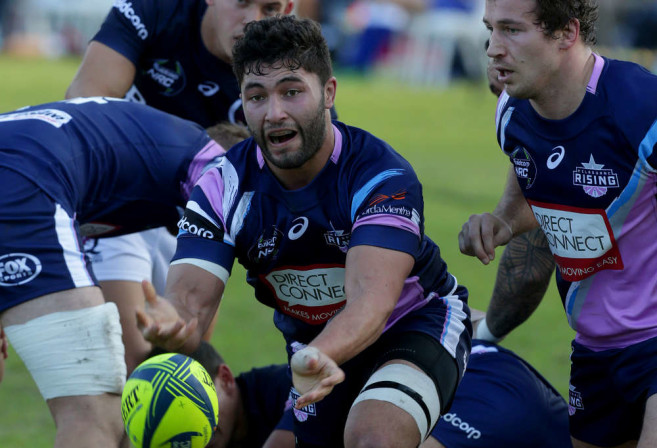With David Pocock off doing David Pocock things in 2017, the Wallabies selectors this year are getting a glimpse of what life might be like post-Rugby World Cup 2019.
By the end of that event, Pocock will be 31. Certainly nowhere near over the hill, but it’s fair to say he’ll be closer to the end of his career than the start.
Given he already qualifies for the Wallabies selection under the ’60 + 7′ allowance now, you can expect the overseas offers for his services from 2020 and onwards will come flooding in. He’s already had a taste, playing with Panasonic in Japan in the season just gone.
And with an overseas contract and big money comes pressure for overseas employers to curb his international availability. In short, any Tests Pocock plays after RWC2019 should probably be seen as a bonus.
But never mind 2020 for now, the openside problems for the Wallabies are much more immediate.
With Pocock currently out of the picture, 2017 could have been the prime opportunity for Liam Gill to gain some major international experience. When Gill joined Toulon for the next few years, I can imagine the table in the Wallabies’ selection room copped a thumping. Regardless of how he was used in recent seasons, Gill had to be firmly in the frame for 2017 plans.
And this is where the current situation starts becoming a worry.
It’s a given that Michael Hooper will wear the Wallabies no.7 jersey this year. Depending on Stephen Moore’s form leading onto the international season, Hooper could be the Australian Captain, too.
But who’s his openside understudy?
And more worryingly, who takes the Wallabies’ no.7 if Hooper, god forbid, was hit by a bus tomorrow?
Watching the Waratahs captain’s monumental performance against the Rebels last week, and another typically solid outing again on Sunday afternoon against the Crusaders rammed home one thing for me: Australia’s backrow stocks aren’t what they were not that long ago.
The hardest part about this consideration is just how quick the situation has changed, as outlined by the pars above.
Wallabies coach Michael Cheika quite publicly stated that he was trying to talk Gill out of signing with Toulon last year, and even after Gill did sign, Cheika delayed his arrival in France by keeping Gill in the Australian squad. 2017 requirements had to have been a major reason for Cheika’s annoyance at the time.
So in thinking about the next in line behind Hooper, we can probably rule out 36 year-old George Smith, and 35 year-old Matt Hodgson. Hodgson is only just back playing in the last fortnight, and Smith is certainly playing well enough; you’d never fully shut the door. But with an eye to 2019, it should be pretty well jammed on both guys.
Colby Fainga’a, I’d suggest, is the next in line.

Like Hooper, Fainga’a has been a lone hand for much of this season, certainly among his side’s best and more consistent players over the opening rounds.
He doesn’t carry as much as Hooper – who does – but he averages around five metres per carry, only about a metre behind Hooper. He’s also managed a tackle bust every four or five carries, and has been a good link man between the Melbourne Rebels’ forwards and backs, when they have managed to get it right.
Defensively, Fainga’a has both made and missed fewer tackles than Hooper, but at a much higher success rate and with better tackle effectiveness, too.
Over the ball, the Brumbies’ Chris Alcock has the most pilfers, but I’d think he’d need to strong together more games before he truly entered the discussion. Fainga’a and Hooper have similar numbers of pilfers, but Fainga’a is well ahead in terms of penalties won at the breakdown.
It feels like he’s been in the game forever, but 2017 could be the season where Fainga’a takes his game to the next level. And that might be by necessity, given the current openside stocks, but at least he’s putting up a decent case.
If there’s a smokey here, then I think it’s a young guy who hasn’t actually worn the no.7 jersey this year at all.
Western Force backrower Richard Hardwick had been playing at No.8 this year, until this weekend just gone, where he dropped back to the bench to cover Hodgson starting at openside, and the very promising Isi Naisarani in his first start at No.8.
But Hardwick has still been playing like an openside, with he and fellow Western Australian local Kane Koteka playing a very similar 7-8 combination to what Hooper and Pocock played for Australia in recent seasons.
The NRC Player of the Final, and probably the dominant opensider in the NRC last season, Hardwick’s numbers this season are similar to Hooper and Fainga’a as well.
He hasn’t quite carried as much as Fainga’a, but makes more ground; he’s a lineout option, has given away significantly less penalties, and has the best tackle effectiveness of any Australian openside this season. He’s strong over the ball, too, forcing almost as many breakdown penalties as Fainga’a.
It’s worth remembering Cheika’s reasoning for bringing Brumbies scrumhalf Joe Powell into Wallabies camp last season; the same criteria would definitely fit for Hardwick, and if Cheika is genuinely wanting to build the talent pool, then the 22 year-old flanker is definitely worth looking at this season.
Watching Hooper at the moment, it’s very obvious that he shouldn’t be going anywhere near busses; not just for his own safety, but for the good of Australian rugby.
But regardless, it’s at least nice to know there’s a couple of ready-made alternatives in Melbourne and Perth, of all places, ready to grab an opportunity.






























































































